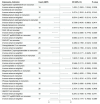Exploring the causal relationship of gut microbiota in nonunion: a Mendelian randomization analysis mediated by immune cell
- PMID: 39736989
- PMCID: PMC11683590
- DOI: 10.3389/fmicb.2024.1447877
Exploring the causal relationship of gut microbiota in nonunion: a Mendelian randomization analysis mediated by immune cell
Abstract
Background: Emerging research indicates that gut microbiota (GM) are pivotal in the regulation of immune-mediated bone diseases. Nonunion, a bone metabolic disorder, has an unclear causal relationship with GM and immune cells. This study aims to elucidate the causal relationship between GM and nonunion using Mendelian Randomization (MR) and to explore the mediating role of immune cells.
Methods: Using a two-step, two-sample Mendelian randomization approach, this study explores the causal link between GM and nonunion, as well as the mediating role of immune cells in this relationship. Data were sourced from multiple cohorts and consortiums, including the MiBioGen consortium. GM data were derived from a recently published dataset of 473 gut microbiota, and nonunion data were obtained from genome-wide association studies (GWAS).
Results: MR analysis identified 12 bacterial genera with protective effects against nonunion and seven bacterial genera associated with a higher risk of nonunion, including Agathobacter sp000434275, Aureimonas, Clostridium M, Lachnospirales, Megamonas funiformis, and Peptoccia. Reverse MR analysis indicated that nonunion does not influence GM. Additionally, MR analysis identified 12 immune cell types positively associated with nonunion and 14 immune cell types negatively associated with nonunion. Building on these findings, we conducted mediation MR analysis to identify 24 crucial GM and immune cell-mediated relationships affecting nonunion. Notably, Campylobacter D, Megamonas funiformis, Agathobacter sp000434275, Lachnospirales, Clostridium E sporosphaeroides, and Clostridium M significantly regulated nonunion through multiple immune cell characteristics.
Conclusions: To our knowledge, our research results are the first to emphasize a causal relationship between the gut microbiome and nonunion, potentially mediated by immune cells. The correlations and mediation effects identified in our study provide valuable insights into potential therapeutic strategies targeting the gut microbiome, informing global action plans.
Keywords: Mendelian randomization; gut microbiota; immune cell; instrumental variable; nonunion.
Copyright © 2024 Yu, Gong, Li, Wu and Hu.
Conflict of interest statement
The authors declare that the research was conducted in the absence of any commercial or financial relationships that could be construed as a potential conflict of interest.
Figures










Similar articles
-
Causal effects between gut microbiota and endometriosis: a two-sample Mendelian randomisation study.J Obstet Gynaecol. 2024 Dec;44(1):2362415. doi: 10.1080/01443615.2024.2362415. Epub 2024 Jun 17. J Obstet Gynaecol. 2024. PMID: 38885114
-
Causal effects of gut microbiota, metabolites, immune cells, liposomes, and inflammatory proteins on anorexia nervosa: A mediation joint multi-omics Mendelian randomization analysis.J Affect Disord. 2025 Jan 1;368:343-358. doi: 10.1016/j.jad.2024.09.115. Epub 2024 Sep 17. J Affect Disord. 2025. PMID: 39299582
-
Causality between gut microbiota, immune cells, and breast cancer: Mendelian randomization analysis.Medicine (Baltimore). 2024 Dec 6;103(49):e40815. doi: 10.1097/MD.0000000000040815. Medicine (Baltimore). 2024. PMID: 39654239 Free PMC article.
-
Exploring the potential causal relationship between gut microbiota and heart failure: A two-sample mendelian randomization study combined with the geo database.Curr Probl Cardiol. 2024 Feb;49(2):102235. doi: 10.1016/j.cpcardiol.2023.102235. Epub 2023 Nov 30. Curr Probl Cardiol. 2024. PMID: 38040216 Review.
-
Causal Exposures in Pancreatic Cancer Incidence: Insights From Mendelian Randomization Studies.JGH Open. 2025 Feb 3;9(2):e70105. doi: 10.1002/jgh3.70105. eCollection 2025 Feb. JGH Open. 2025. PMID: 39906083 Free PMC article. Review.
References
-
- Askalonov A. A., Gordienko S. M., Avdyunicheva O. E., Bondarenko A. V., Voronkov S. F. (1987). The role of T-system immunity in reparatory regeneration of the bone tissue in animals. J. Hyg. Epidemiol. Microbiol. Immunol. 31, 219–224. - PubMed
-
- Bissinger O., Kreutzer K., Götz C., Hapfelmeier A., Pautke C., Vogt S., et al. . (2016). A biomechanical, micro-computertomographic and histological analysis of the influence of diclofenac and prednisolone on fracture healing in vivo. BMC Musculoskelet. Disord. 17:383. 10.1186/s12891-016-1241-2 - DOI - PMC - PubMed
LinkOut - more resources
Full Text Sources

